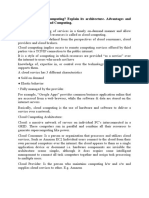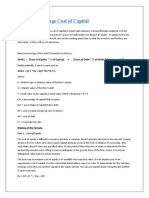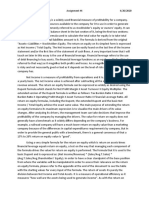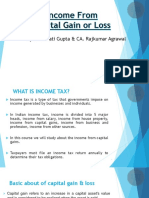Solutions For Exercise Sheet 4
Solutions For Exercise Sheet 4
Uploaded by
FlaminiaCopyright:
Available Formats
Solutions For Exercise Sheet 4
Solutions For Exercise Sheet 4
Uploaded by
FlaminiaOriginal Description:
Original Title
Copyright
Available Formats
Share this document
Did you find this document useful?
Is this content inappropriate?
Copyright:
Available Formats
Solutions For Exercise Sheet 4
Solutions For Exercise Sheet 4
Uploaded by
FlaminiaCopyright:
Available Formats
Advanced Corproate Finance, 2019/20
Advanced Corporate Finance
Solution to Exercise Sheet 4
Modigliani Miller, EPS, PE
GlaxoSmithKline plc (GSK) is global healthcare group. The following numbers are rounded
numbers from their 2017 financial statements. We assume for simplification that there are no
taxes.
a. If the risk free rate is 3% and the market risk premium 6%, what would be an appropriate
long term annual return for the equity of GlaxoSmithKline, given that the beta of
GlaxoSmithKline’s equity is 0.6.
Appropriate return [CAPM] = risk free rate + beta * Market Risk Premium
=3% + 0.6 * 6% = 6.6%
The appropriate return for an investment in GlaxoSmithKline’s equity amounts to 6.6%.
b. GlaxoSmithKline has a total debt level of 20 billion and the market capitalization of the
company’s equity is 125 billion. The current CEO thinks that the company is under-levered.
He wants to change the structure of the liabilities by increasing debt to 70 billion and
reducing the market capitalization to 75 billion. How would this operation affect the
company’s beta? Please calculate the beta the company’s shares should have after the change
in capital structure, assuming that the debt is risk free and the company does not pay taxes.
The company`s asset or unlevered beta will not be affected by this kind of operation as the
debt beta is considered to be entirely risk free, hence numbers to 0. However, the equity beta
will increase due to the increase of leverage.
Calculation of asset beta given the capital structure before the recapitalization:
= (equity beta *Equity) / Enterprise Value = 0.6 * (125 / 145) = 0,52
Calculation of equity beta after the recapitalization:
= (asset beta * Enterprise Value) / Equity = (0.52 * 145) / 75 = 1,00
c. What should be the cost of equity after the company’s change in capital structure? What
should be the weighted average cost of capital. Assume that the company pays 3% interest
before and that bankruptcy risk is negligible even after the change in capital structure.
Cost of Equity [CAPM] = risk free rate + equity beta * Market Risk Premium
Cost of Equity (after recapitalization) = 3% + (1,00 * 6%) = 9,00%
WACC = cost of equity * (Equity / EV) + cost of debt * (Debt / EV)
WACC (before recapitalization)= 6.6%% * (125 / 145) + 3% * (20 / 145) = 6.1%
WACC (after recapitalization)= 9,00% * (75 / 145) + 3% * (70 / 145) = 6.1%
Prof. Michael Troege, ESCP Europe
Advanced Corproate Finance, 2019/20
Whereas the cost of equity has been increased due to the increase in leverage, the WACC has
been unaffected by the recapitalization. This was to be anticipated given the theorems of
Modgliani & Miller in a scenario without the existence of taxes. With taxes EV would have
slightly increased and WACC decreased.
d. The company’s net income is 4,7 billion, there are 2.5billion shares trading at $50. The book
value of equity is 5.8billion. Please determine ROE and EPS
Return on Equity = Net Income / Equity
ROE (based on book value) = 4.7 / 5.8 = 81%
ROE (based on market value) = 4.7 / (2.5 * 50) = 3.76%
Earnings per share = Net Income / number of shares
EPS = 4.7 / 2.5 = 1.88
e. How will these numbers be affected by the planned recapitalization? Assume that the
company buys back shares at the current market price.
We know that EPS numbers go up with leverage in case earnings yield=1/PE>rD. (see class
or extra reading on the supplement section of Blackboard) This is the case here as the
earnings yield is 4,7/125=3,7%.
We also know that leverage increases ROE in case EBIT/ Book Assets=ROA>rD.
In this case we have EBIT ≈ 4,7+20*0,03=5,3 and Book Assets ≈ Book Value of Equity +
Debt =25,8, hence ROA=5,3/25,8=20,5%>rD, hence the operation will increase ROE.
f. Bristol-Myers Squibb Co. another healthcare group, has the following key financials: Net
Income : 2.5billion; Shareholders Equity (book value): 15billion; Market Capitalization:
97billion; Number of shares outstanding : 16billion; Total (book) assets 38billion; EBIT 2,8
billion. Use these numbers to quickly identify the qualitative effects of 30billion increase in
debt on ROE, PE and EPS.
ROE (based on book value) = NI/SHE = 16.91%
ROA= 2,8/38=7,3% this is likely higher than cost of debt, hence the operation will increase
ROE
PE = Market Cap/NI = 37.91 ,hence earnings yield is only 1/37,9=2,6%. This is likely to be
lower than the (tax adjusted) interest rate, hence the operation will decrease EPS
EPS = NI/# Shares = 1.54
Prof. Michael Troege, ESCP Europe
You might also like
- Ricoh mpc307 407 Service ManualDocument1,001 pagesRicoh mpc307 407 Service Manualmark adams100% (3)
- American Home Products CorporationDocument25 pagesAmerican Home Products Corporationchaku181193% (15)
- Cloud Computing Important Questions & AnswersDocument14 pagesCloud Computing Important Questions & AnswersEr Saroj Chaudhary100% (7)
- Case Study (WACC)Document17 pagesCase Study (WACC)Joshua Hines100% (1)
- Case BBBYDocument7 pagesCase BBBYgregordejong100% (1)
- Blain Kitchenware Inc.: Capital StructureDocument7 pagesBlain Kitchenware Inc.: Capital StructureRoy Lambert100% (4)
- Marriot Corp. Finance Case StudyDocument5 pagesMarriot Corp. Finance Case StudyJuanNo ratings yet
- List of Key Financial Ratios: Formulas and Calculation Examples Defined for Different Types of Profitability Ratios and the Other Most Important Financial RatiosFrom EverandList of Key Financial Ratios: Formulas and Calculation Examples Defined for Different Types of Profitability Ratios and the Other Most Important Financial RatiosNo ratings yet
- PFM CHAP 22 All SolutionsDocument22 pagesPFM CHAP 22 All Solutionsjanay martin100% (1)
- CF - Questions and Practice Problems - Chapter 18Document4 pagesCF - Questions and Practice Problems - Chapter 18Lê Hoàng Long NguyễnNo ratings yet
- Corporate Finances Problems Solutions Ch.18Document9 pagesCorporate Finances Problems Solutions Ch.18Egzona FidaNo ratings yet
- Exercise Sheet 2 With SolutionsDocument8 pagesExercise Sheet 2 With SolutionsFlaminiaNo ratings yet
- Cap Struc TheoriesjDocument19 pagesCap Struc TheoriesjPratik AhluwaliaNo ratings yet
- CV Midterm Exam 1 - Solution GuideDocument11 pagesCV Midterm Exam 1 - Solution GuideKala Paul100% (1)
- Chapter 19: Financial Statement AnalysisDocument11 pagesChapter 19: Financial Statement AnalysisSilviu TrebuianNo ratings yet
- Chapter 19 BKM Investments 9e SolutionsDocument11 pagesChapter 19 BKM Investments 9e Solutionsnpiper29100% (1)
- CF - Questions and Practice Problems - Chapter 18Document5 pagesCF - Questions and Practice Problems - Chapter 18Mai PhạmNo ratings yet
- Final Review Session SPR12RปDocument10 pagesFinal Review Session SPR12RปFight FionaNo ratings yet
- CF - Questions and Practice Problems - Chapter 17Document5 pagesCF - Questions and Practice Problems - Chapter 17Kiềuu AnnhNo ratings yet
- Caluclation of VoidDocument8 pagesCaluclation of VoidفتىالصحراءفتىالصحراءNo ratings yet
- Leverage: Let's DiscussDocument9 pagesLeverage: Let's DiscussClaudette ManaloNo ratings yet
- Dmp3e Ch05 Solutions 02.28.10 FinalDocument37 pagesDmp3e Ch05 Solutions 02.28.10 Finalmichaelkwok1No ratings yet
- Analysis - Section 2Document4 pagesAnalysis - Section 2CHEE HAO XUANNo ratings yet
- Example MidlandDocument5 pagesExample Midlandtdavis1234No ratings yet
- 2.estimating Inputs For ValuationDocument22 pages2.estimating Inputs For ValuationAbhi Krishna ShresthaNo ratings yet
- Answers To Concepts Review and Critical Thinking QuestionsDocument7 pagesAnswers To Concepts Review and Critical Thinking QuestionsMohitNo ratings yet
- Leverage: - Compiled by - Sapna Bhupendra Jain 98112-55704Document7 pagesLeverage: - Compiled by - Sapna Bhupendra Jain 98112-55704casapnaNo ratings yet
- E3 The Capital Asset Pricing Model Part 2Document6 pagesE3 The Capital Asset Pricing Model Part 2TENGKU ANIS TENGKU YUSMANo ratings yet
- Fin 370 Week 5 Final ExamDocument12 pagesFin 370 Week 5 Final ExamECO 372 Week 5 Final ExaminationNo ratings yet
- Cost of CapitalDocument20 pagesCost of CapitalTú Anh Nguyễn ThịNo ratings yet
- 4 The Firm's Capital Structure and Degree of LeverageDocument9 pages4 The Firm's Capital Structure and Degree of LeverageMariel GarraNo ratings yet
- Weighted Average Cost of CapitalDocument3 pagesWeighted Average Cost of Capital1abhishek1No ratings yet
- Answer To 1aDocument28 pagesAnswer To 1asharib zaidiNo ratings yet
- FM - Financing Decision Session 15Document45 pagesFM - Financing Decision Session 15ipm02ananyajNo ratings yet
- Assignment 4 Management 4300Document3 pagesAssignment 4 Management 4300Victor Marcos HyslopNo ratings yet
- PART-A (Closed Book) (75 Mins)Document4 pagesPART-A (Closed Book) (75 Mins)DEVANSH CHANDRAWATNo ratings yet
- CFA Level 2 Equity Valuation Study ExamplesDocument6 pagesCFA Level 2 Equity Valuation Study ExamplessaurabhNo ratings yet
- Lecture 3 - Assignment - Jaimin PandyaDocument10 pagesLecture 3 - Assignment - Jaimin PandyajaiminNo ratings yet
- Lbo ReportDocument9 pagesLbo ReportNikhilesh MoreNo ratings yet
- Management Control Systems: University Question - AnswersDocument19 pagesManagement Control Systems: University Question - AnswersvaishalikatkadeNo ratings yet
- Financial AnalysisDocument19 pagesFinancial AnalysisKennedy ChombaNo ratings yet
- Chap 3 SolutionsDocument70 pagesChap 3 SolutionsHoàng Huy80% (10)
- Capm Ta 2Document6 pagesCapm Ta 2Olivier MNo ratings yet
- Problems Relating To Capital Structure and Leverage 1Document9 pagesProblems Relating To Capital Structure and Leverage 1Montasir MahmudNo ratings yet
- Chapter 25. Tool Kit For Mergers, Lbos, Divestitures, and Holding CompaniesDocument22 pagesChapter 25. Tool Kit For Mergers, Lbos, Divestitures, and Holding CompaniesPrashantKNo ratings yet
- Tutorial 3 QuestionsDocument6 pagesTutorial 3 QuestionshrfjbjrfrfNo ratings yet
- Chapter 8 - MinicaseDocument9 pagesChapter 8 - MinicaseJonathan WilderNo ratings yet
- Cost of Capital of UK CompaniesDocument8 pagesCost of Capital of UK CompaniesSonia AgarwalNo ratings yet
- BUS 497a - Homework 1 - Solution GuideDocument5 pagesBUS 497a - Homework 1 - Solution GuidesaltyaxelNo ratings yet
- Sainsbury JDocument34 pagesSainsbury JdivyaNo ratings yet
- Nanyang Business School AB1201 Financial Management Tutorial 10: Capital Structure and Leverage (Common Questions)Document4 pagesNanyang Business School AB1201 Financial Management Tutorial 10: Capital Structure and Leverage (Common Questions)asdsadsaNo ratings yet
- Corporate FinanceDocument15 pagesCorporate Financecaglar ozyesilNo ratings yet
- Technical Analysis of The Size PremiumDocument4 pagesTechnical Analysis of The Size PremiumRamiro Gamen0% (1)
- GRETA Chinh SuaDocument10 pagesGRETA Chinh SuaHưng NguyễnNo ratings yet
- Concept Questions: Chapter Twelve The Analysis of Growth and Sustainable EarningsDocument64 pagesConcept Questions: Chapter Twelve The Analysis of Growth and Sustainable EarningsceojiNo ratings yet
- CFR Sample QuestionsDocument10 pagesCFR Sample Questionsisgigles157No ratings yet
- Solved Examples Based On Ebit-Eps Analysis - Part 1 Example Help For Leverage, Management, Homework Help - Transtutors - ComDocument3 pagesSolved Examples Based On Ebit-Eps Analysis - Part 1 Example Help For Leverage, Management, Homework Help - Transtutors - Communish12345650% (2)
- Valuation: Future Growth and Cash FlowsDocument12 pagesValuation: Future Growth and Cash FlowsAnshik BansalNo ratings yet
- Capital Structure Management in Practice: Answers To QuestionsDocument20 pagesCapital Structure Management in Practice: Answers To QuestionsJenifer GaliciaNo ratings yet
- Practice Questions Before The Final Fall 2014Document4 pagesPractice Questions Before The Final Fall 2014rheg3070No ratings yet
- Chapter 2 Review of Financial Statement Preparation Analysis InterpretationDocument46 pagesChapter 2 Review of Financial Statement Preparation Analysis InterpretationMark DavidNo ratings yet
- List of the Most Important Financial Ratios: Formulas and Calculation Examples Defined for Different Types of Key Financial RatiosFrom EverandList of the Most Important Financial Ratios: Formulas and Calculation Examples Defined for Different Types of Key Financial RatiosNo ratings yet
- 06 ACF Asymmetric Information I Moral Hazard 2020-21Document48 pages06 ACF Asymmetric Information I Moral Hazard 2020-21FlaminiaNo ratings yet
- Solutions For Exercise Sheet 7Document2 pagesSolutions For Exercise Sheet 7FlaminiaNo ratings yet
- Solutions For Exercise Sheet 3Document4 pagesSolutions For Exercise Sheet 3FlaminiaNo ratings yet
- 04 ACF Risk and Capital StructureDocument65 pages04 ACF Risk and Capital StructureFlaminiaNo ratings yet
- 03 ACF Modigliani MillerDocument90 pages03 ACF Modigliani MillerFlaminiaNo ratings yet
- Exercise Sheet 1 With SolutionsDocument3 pagesExercise Sheet 1 With SolutionsFlaminiaNo ratings yet
- 02 ACF Bonds Stocks Projects CompaniesDocument67 pages02 ACF Bonds Stocks Projects CompaniesFlaminiaNo ratings yet
- Working at Height SopDocument6 pagesWorking at Height SopAlketa ZakaNo ratings yet
- Corporate Social ResponsibilityDocument3 pagesCorporate Social Responsibilityabdirzak abdullahiNo ratings yet
- Capital GainDocument38 pagesCapital GainD. Naarayan NandanNo ratings yet
- Hi There.: How To Use These Blog Post TemplatesDocument30 pagesHi There.: How To Use These Blog Post TemplatesTime Card on ScribdNo ratings yet
- Reg0000010675781Document2 pagesReg0000010675781Daljeet SinghNo ratings yet
- Go To Market Strategy-CreativeDocument14 pagesGo To Market Strategy-CreativeNahruddin MaiNo ratings yet
- Kybernetes: Article InformationDocument21 pagesKybernetes: Article InformationMUHAMMAD USMAN KHANNo ratings yet
- Chapter - 6 Investment EvaluationDocument33 pagesChapter - 6 Investment EvaluationbelaynehNo ratings yet
- EKII IUP Week 8 - Multinational Financial ManagementDocument30 pagesEKII IUP Week 8 - Multinational Financial Managementindah rahmaNo ratings yet
- IIFL Wealth Hurun India Rich List 2021Document26 pagesIIFL Wealth Hurun India Rich List 2021maghucoolNo ratings yet
- AIS Chapter 21Document51 pagesAIS Chapter 21Janysse CalderonNo ratings yet
- Advance Accounting - Dayag 2015. Chapter 7 Problem IIIDocument1 pageAdvance Accounting - Dayag 2015. Chapter 7 Problem IIIJohn Carlos DoringoNo ratings yet
- 3865XXXXXXXXX949818 09 2022Document9 pages3865XXXXXXXXX949818 09 2022Shalini PandeyNo ratings yet
- ArimaDocument1 pageArimachrisgerraymundguancoNo ratings yet
- Masters' Union Placement Report Cohort of 2023Document27 pagesMasters' Union Placement Report Cohort of 2023Arjun PanditNo ratings yet
- Mcdonald'S Case Study: Prepared By: Isha Aggarwal Section: PGDM 1Document11 pagesMcdonald'S Case Study: Prepared By: Isha Aggarwal Section: PGDM 1piyush rawatNo ratings yet
- 5 Outline of Revised Transport Master Plan by Jutpi: 1) OverviewDocument56 pages5 Outline of Revised Transport Master Plan by Jutpi: 1) Overview4chi11es50% (2)
- Audit Checklist (HR)Document2 pagesAudit Checklist (HR)hemant saraswatNo ratings yet
- What Is An Official ReceiptDocument3 pagesWhat Is An Official ReceiptNelson Louie Maaño Ricerra IIINo ratings yet
- Proposal Business Canva TeamDocument16 pagesProposal Business Canva Teamziziannisa4No ratings yet
- EOU Test HP3 Unit 6Document6 pagesEOU Test HP3 Unit 6Ngân Hạnh50% (2)
- MBMK 6001 Sales and Distribution Managaent1Document9 pagesMBMK 6001 Sales and Distribution Managaent1Vaibhav BhatnagarNo ratings yet
- Sample - Drones Market (2019 - 2024) - Mordor Intelligence PDFDocument36 pagesSample - Drones Market (2019 - 2024) - Mordor Intelligence PDFAlejandro Uribe Lopez50% (2)
- Confidential: Binding Term Sheet by and BetweenDocument4 pagesConfidential: Binding Term Sheet by and Betweenmuhammad arhamNo ratings yet
- Accounting TUTORIALDocument68 pagesAccounting TUTORIALFallen LeavesNo ratings yet
- Turning (Lathe) - Group 2Document31 pagesTurning (Lathe) - Group 2Paul Christian GerobinNo ratings yet
- MDIDocument2 pagesMDIManju BhagtaniNo ratings yet
































































































